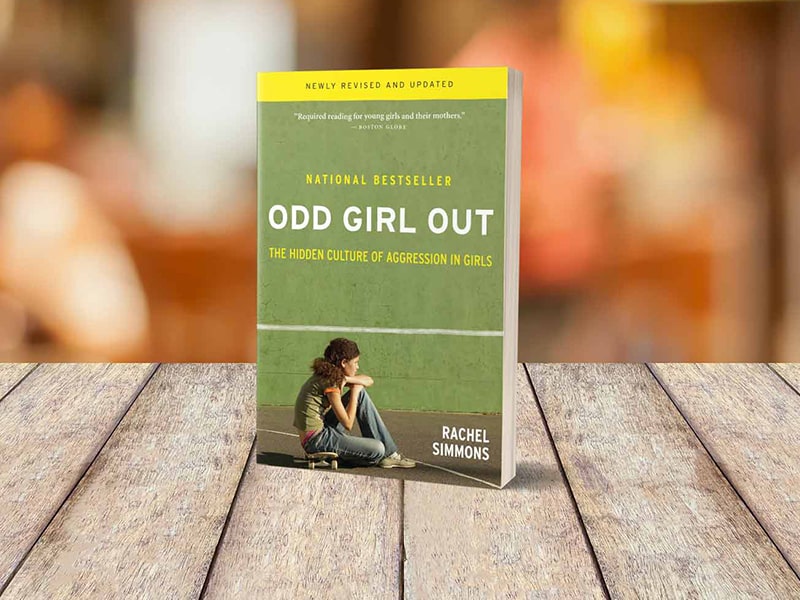What Can We Learn from “Odd Girl Out: The Hidden Culture of Aggression in Girls”?
A guide for teachers and students on reading and understanding the plot of “Odd Girl Out: The Hidden Culture of Aggression in Girls” by Rachel Simmons. This guide is an alternative to CliffsNotes and SparkNotes. It dives deep into the story to discover hidden meaning and analyze themes, messages, and ideas for write a book report for me‘ essay topics.
Rachel Simmons wrote a nonfiction book to discuss and focus on the perceptions of girls and their means of expressing anger in a cultural environment. Notably, our culture is ready to accept aggression from boys but does not respond well to the same tendencies in girls. The author is a journalist who uses her observations and experiences to write about a gap in anger expression related to gender and culture.
Girls’ Anger as a Theme of the Book
The author addresses cultural norms that force girls to suppress their anger and choose bullying and other destructive patterns. Simmons supports this argument by providing examples of girls creating derogatory notes, purposely excluding others from small social groups, and using more methods of indirect aggression. According to Simmons, such expressions of negative emotions in girls are harmful. In “Odd Girl Out,” the author also states that females should focus on a conflict and resolve it directly rather than use hidden means and ways that may be psychologically destructive.
Simmons masterfully draws attention to some of the most common yet devastating acts showing suppressed anger. As such, girls can spread rumors, backstab, manipulate and cause psychological pain in other ways. These methods of indirect attacks are used by females, similar to how males use their fists to show anger.
The issue is that different forms of manipulations often go unnoticed even by parents and teachers. As a result, they become a norm and increase in their manifestations and cruelty level. It is painful to witness that girls tend to see friendship as a potential weapon. The author wants readers to recognize these elements as serious matters and take action.
“Odd Girl Out”: Research at the Root of the Story
Simmons argues several points concerning the danger of suppressed anger in girls and cultural norms that have negative effects on people. In doing so, she uses analysis and research data to add credibility and make the story more compelling.
The primary source for writing a book is interviews with 300 girls. The sample for this work was carefully selected from 10 different schools located in several areas of the United States. The girls were of different ages (from 9 to 15 years old), and various socioeconomic and racial backgrounds.
Simmons stresses that it was the girls’ voices that were most important, not her own. It was important for her not to lecture the girls about bullying in a way that would offend them. By accepting their capacity to be bullies and aggressive, she was able to gain insight into the minds of those who bullied and not only the victims of such behavior. Among the subjects she interviewed were 50 women who had been victims of aggression in their school years. The author used their story to conduct a compelling analysis.
Real-Life Cases that Unveil Girls’ Anger
There is one story that stands out from the rest. Simmons focuses readers’ attention on Michelle, her bullying behavior, and a destroyed friendship. When Michelle meets Erin, the two girls bond immediately until the moment when Erin confesses her attraction to a boy that Michelle also likes for some time. This confession makes Michelle angry, and the feeling only grows when Erin starts dating him. However, Michelle keeps her feelings to herself to prevent Erin from possibly manipulating the situation and making Michelle the cause of the problem. The girls also have an unfriendly academic competition and build tension in the relationship. Later, Michelle connects with other girls who have some issues with Erin and initiates an organized, however, indirect attacks on Erin by using different means that include but are not limited to aggressive e-mail messages and social isolation. Such bullying continued for about 2 years until Erin was hospitalized in a psychiatric clinic.
The story about Michelle and Erin serves as an example of bullying that substitutes direct expressions of anger. The author argues that if these girls felt free to express their negative feelings, they would have been empowered to manage them with minimal negative consequences. According to the author and her research, this story supports the argument that the problem is a social taboo on anger expression in girls.
Sources and Stories that Reinforce the Main Arguments
The fact that the author uses real stories stresses the importance of the considered issue. Publishers Weekly, for instance, indicates that sometimes even 16 years is not enough to forget undisclosed manifestations of anger. As such, a girl may always remember when other girls were told not to play with her or used other forms of ‘alternative aggression.’ Readers have to evaluate instances of such aggression and finally recognize that girls often use friendship as a weapon to cause pain.
Simmons also uses the work published by Carol Gilligan and Lyn Mikel Brown to discuss hidden means of expressing aggression and their impact on girls’ self-esteem and mental health in general. Simmons cites other authors to reinforce the argument that social restraints on anger expression are largely responsible for bullying in the circle of girls. Moreover, Simmons compares suppressed anger to a game of Twister when she says that girls have to cover their true feelings and find unconventional ways of anger outlets.
What Is so Odd in Girls’ Anger? Simmons Explains
The theme of bullying is developed using different examples and cases. For instance, the author describes dirty looks and taunting notes as odd behavior in girls. With this book, Simmons has raised awareness of this devastating issue and helped girls, parents, counselors, and teachers recognize and deal with it. It uses real-life examples from both the victim’s perspective and that of the perpetrator to highlight this issue in its paperback edition, aiming to reach a wider audience, including teenagers, who are its target audience. Overall, the author claims that it is odd to make girls suppress direct manifestations of anger because the feeling finds its outlet has devastating long-term implications.
How Boys Are Different in Their Anger?
When boys are angry, they use rather obvious and direct ways to show it and rarely rely on hidden means such as manipulations and other similar methods. Often, boys’ anger is described as bad behavior and includes mainly physical aggression (for instance, fights) that cannot go unnoticed. Such behavior does compare to the subtle signs of aggression shared by females.
Unlike girls, boys seldom use indirect aggression and manipulate friendships. In fact, their response to anger is much healthier from a mental point of view. Simmons also indicates that without cultural consent to show anger, girls use the fear of losing friendships as their emotional mechanism of action. In Odd Girl Out, the author explains the scale of the gap between girls and boys in terms of their emotional regulation according to social standards.
Readers’ Responses to the Book by Simmons
The book Odd Girl Out was well-accepted by the readers and became a bestseller. It also initiated conversations about the main message of the book and ignited interest in the hidden culture of female bullying and social norms of anger expression based on gender. The book was praised for its description of anger in girls, including such elements as:
- Dirty looks and other non-verbal means;
- Notes with offensive content;
- Social exclusion;
- Rumour spreading;
- Manipulation.
It should be pointed out that these anger forms are evident on another level, namely cyberspace, where bullying is a common thing. As such, the book continues to draw interest to its messages and offers strategies to help girls manage anger without negative effects on their health and well-being.
While the first book edition made the author famous, its updated edition became internationally recognized, with Simmons being considered a recognized educator for parents and teachers. The book is widely used to navigate social dynamics related to anger through offered classroom initiatives and suggestions that may be followed to help girls and improve their anger manifestations. Owing to its research and the analysis of numerous stories, the book is an important resource for many to evaluate social constraints and anger expression.
Book Structure and Main Ideas
Every book chapter explores some form of expression of female aggression with the focus on its role during the formative years. Simmons carefully assesses means and methods of bullying as well their roots in relationships between girls, reinforcing main messages.
“If isolation is trauma for girls, there is power to be found in relationships” (82).
A quote about isolation and relationships shows that the author, while trying to point out a problem, also offers solutions and a way to heal that girls often struggle to find even when they get older.
“She has only now, in her late twenties, begun to reconnect with women” (210).
The author wants readers to understand that the pain caused by indirect anger does go away easily. Simmons argues that it is essential to recognize the pressure that young women encounter and how they can carry emotional bruises from high school years to adulthood.
Chapter 4 is particularly interesting because it analyzes the role of social media as a platform for anger expression in girls. The analysis uses a story from one of the interviews and explains that a stream of information online makes it difficult for females to avoid society, offering a chance to, for instance, stalk parties and events to escape social isolation. The danger exists because such an online presence does not overcome the social barriers and can even lead to paranoia.
Chapter 10 is one of the most compelling book sections because it contains practical solutions to the issue of anger expression and ways to deal with bullying as one of its forms. As such, Simmons recommends responding with empathy and openness to aggression. She considers this tactic effective and healing because it helps victims and makes an attack less potent. The author stresses the need to discuss bullying in class and mentions things that should be avoided during discussions. The goal is to prevent further damage and ease the process of recovering from bullying by enabling girls to understand the hidden reasons for it. This approach is important because it empowers girls to deal with aggression and anger in later years since social constraints on showing anger by females do not disappear after high school is over.
To sum up, “Odd Girl Out: The Hidden Culture of Aggression in Girls” can be recommended to readers of different groups, including students, advisors, parents, teachers, and others. While Simmons focuses on girls, she also helps acknowledge the state of things related to anger and bullying in different periods of life. Most importantly, the book emphasizes that there are healthy alternatives to showing anger by girls and teaches to recognize and apply such alternatives.

